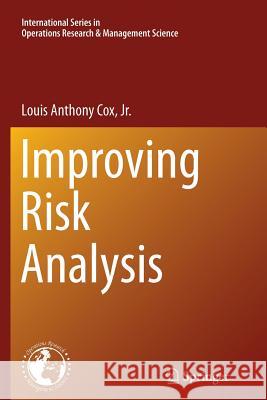Improving Risk Analysis » książka
Improving Risk Analysis
ISBN-13: 9781493901838 / Angielski / Miękka / 2015 / 386 str.
Improving Risk Analysis
ISBN-13: 9781493901838 / Angielski / Miękka / 2015 / 386 str.
(netto: 575,06 VAT: 5%)
Najniższa cena z 30 dni: 578,30
ok. 22 dni roboczych
Bez gwarancji dostawy przed świętami
Darmowa dostawa!
Improving Risk Analysis shows how to better assess and manage uncertain risks when the consequences of alternative actions are in doubt. The constructive methods of causal analysis and risk modeling presented in this monograph will enable to better understand uncertain risks and decide how to manage them.The book is divided into three parts. Parts 1 shows how high-quality risk analysis can improve the clarity and effectiveness of individual, community, and enterprise decisions when the consequences of different choices are uncertain. Part 2 discusses social decisions. Part 3 illustrates these methods and models, showing how to apply them to health effects of particulate air pollution."Tony Cox's new book addresses what risk analysts and policy makers most need to know: How to find out what causes what, and how to quantify the practical differences that changes in risk management practices would make. The constructive methods in Improving Risk Analysis will be invaluable in helping practitioners to deliver more useful insights to inform high-stakes decisions and policy, in areas ranging from disaster planning to counter-terrorism investments to enterprise risk management to air pollution abatement policies. Better risk management is possible and practicable; Improving Risk Analysis explains how."
Elisabeth Pate-Cornell, Stanford University"Improving Risk Analysis offers crucial advice for moving policy-relevant risk analyses towards more defensible, causally-based methods. Tony Cox draws on his extensive experience to offer sound advice and insights that will be invaluable to both policy makers and analysts in strengthening the foundations for important risk analyses. This much-needed book should be required reading for policy makers and policy analysts confronting uncertain risks and seeking more trustworthy risk analyses."
Seth Guikema, Johns Hopkins University"Tony Cox has been a trail blazer in quantitative risk analysis, and his new book gives readers the knowledge and tools needed to cut through the complexity and advocacy inherent in risk analysis. Cox's careful exposition is detailed and thorough, yet accessible to non-technical readers interested in understanding uncertain risks and the outcomes associated with different mitigation actions. Improving Risk Analysis should be required reading for public officials responsible for making policy decisions about how best to protect public health and safety in an uncertain world."
Susan E. Dudley, George Washington University











